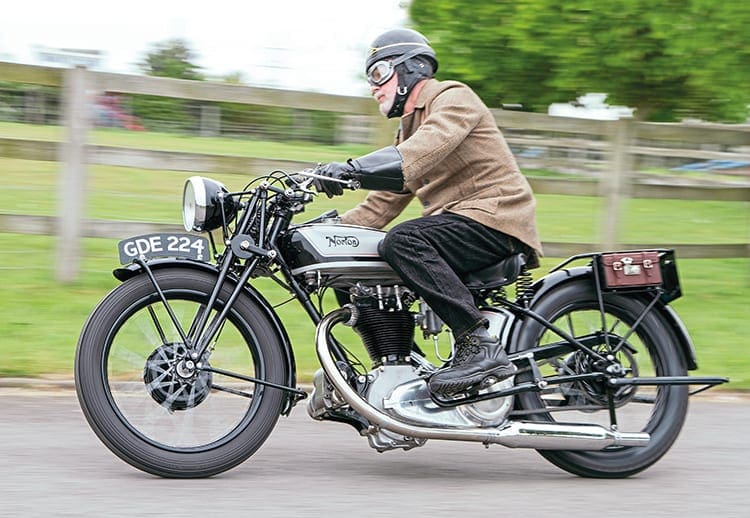
Not all Nortons are deserving of the famous phrase, but this one is.
To say Norton’s designation of its various models was rather obscure is a bit like suggesting Geoff Duke was quite a good racer – true, but a gross understatement.
Enjoy more Classic MotorCycle reading in the monthly magazine.
Click here to subscribe & save.
As well as the occasional use of letters, Norton coined names for the later machines, and through the years model numbers from 1 to 99 were scattered around with no apparent relationship to engine size, frame type, or even the order of introduction.
Unsurprisingly therefore, when Sammy Miller told me he’d just restored a Norton Model 21, I had little idea of what he was talking about. But I’m far from alone in my ignorance; the Model 21 turns out to be one of the rarest variants in existence, and it needed somebody with the encyclopaedic marque knowledge and status of the late Dr George Cohen to authoritatively identify this one.
So what is a Norton 21? Well it appeared in that interim period when Bracebridge Street was graduating out of its vintage phase, and was effectively a hybrid combining features of the better-known ohv ES2 and ohc CS1 models. As Norton aficionados will know, the two models were already closely related with the 1927 CS1 racer being virtually a slightly uprated ES2 frame fitted with the new ‘cammy’ engine. Importantly, a novel feature of that engine was its use of a gear-type pump recirculating the oil (rather than relying on an old-fashioned total-loss system) and when the same arrangement was adopted on the ohv engine it created the Model 21.
The new system was actually quite straighforward but causes a bit of confusion because – unlike later fully automatic systems – there are two controls making it appear to need considerable rider intervention. The more visible control is in the oil feed line and has graduated markings to enable it to be used as a valve to control the flow, the zero setting stopping the flow altogether. The latter aspect probably wasn’t important when these engines were new and in regular use, but – provided you remember to operate it – is nowadays quite a benefit to prevent the wet-sumping promoted by thinner oils, significant lay-up periods and inevitable wear in the pump gears.
The less obvious control is situated at the base of the timing cover and takes a bit more understanding. These engines were described as semi-dry sump (Norton’s catalogue Code Word was ‘DRISUMP’) or semi-wet sump depending on your point of view, because the scavenge side of the pump in the Model 21 or CS1 was arranged to leave just enough oil in the crankcase to wet the crankshaft flywheels as they rotated. The timing-cover control is directly connected to the pick-up tube which Bob Stanley – who dealt with the engine rebuild in Sammy Miller’s workshop – tells me is less than a centimetre in diameter and has a small hole in its side. Oil is drawn through that hole, and rotating the tube via the external knob varies the oil depth in the ‘sump’ by that small amount.
That might seem simultaneously crude yet over-complicated, and it’s true that once set, the control doesn’t need to be altered very often. But it’s quite a nifty safety feature which must have been comforting for owners of the period who had yet to develop full faith in automatic oiling. If the delivery side of the pump failed or the oil tank became emptied for whatever reason, riders could reset the control to raise the level in the sump, whereupon there would be enough ‘splash’ lubrication to get them home. Naturally the oil in the sump tended to slosh around all the time in any case, and that’s why you might well see a Norton of this type emitting an extra cloud of exhaust smoke when it goes over a bump in the road.
Going back to the Model 21 in particular we see that it has quite a few other features indicating it was made at the end of the vintage period. The valve gear in particular is absolutely typical. From the right it looks fairly modern with enclosed pushrods, but from the left you can see that the rocker assembly is simply mounted on pillars extending above the cylinder head, with valve springs and stems exposed to the elements, and relying on manual lubrication.
The Sturmey Archer gearbox is unashamedly vintage with only three ratios changed by a long hand-operated lever without the help of a positive-stop mechanism, or even a ‘gate’ to help the rider reliably select the desired gear. Other vintage echoes are seen in the elegant but expensive inverted handlebar levers and the provision of separate stands for front and rear wheels.
The forward position of the Magdyno looks slightly archaic too, as well as exposing the device (which would normally have an alloy or pressed steel shield) to rain and mud splashing up from the front wheel.
The lighting set would have been an optional extra at this time, and would doubtless have been more common on the touring 21 than on its more sporting CS1 sibling (whose magneto was in a more protected position behind its cylinder). Probably because of the Model 21’s prominent timing chest its exhaust runs down the left-hand side of the bike – putting it at odds with convention – and after a post-Model 21 experiment with an ungainly cross-over pipe, Norton re-designed the cylinder head to suit a right-hand exhaust.
Read the full story in The Classic MotorCycle August 2018
Advert
 Enjoy more The Classic MotorCycle reading in the monthly magazine. Click here to subscribe.
Enjoy more The Classic MotorCycle reading in the monthly magazine. Click here to subscribe.



